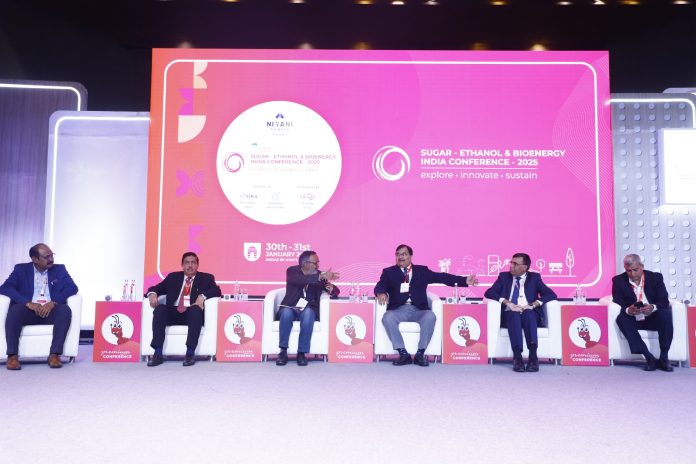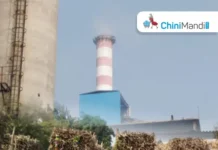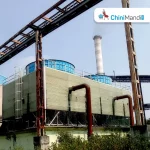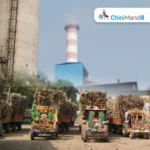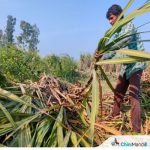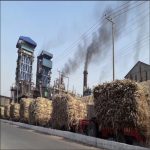SEIC 2025 kickstarted on 30th January in New Delhi with a resounding inaugural session. The Union Minister of Road Transport and Highways Nitin Gadkari spoke about the bright future of the sugar industry, and the potential it has to contribute to 3% of the country’s GDP.
Following the inaugural session, the 1st panel discussion of the conference took place post lunch.
Topic of the discussion- Policy Advocacy to Accelerate Growth
Moderator: Harish Damodaran, National Rural Affairs and Agriculture Editor, The Indian Express
Panellists:
Atul Chaturvedi, Executive Chairman, Shree Renuka Sugars Limited
Prakash Naiknavare, M.D., National Federation of Cooperative Sugar Factories
Roshan Lal Tamak, CEO, DCM Shriram LTD
Dr.Tushar Patil Asst. Vice President, Corporate Strategy, Praj Industries
Pankaj Rastogi, Executive Director, Dalmia Bharat Sugar & Industries Limited
The Moderator opened the discussion with questions on domestic sugar consumption demand and export prospects.
Atul Chaturvedi said, “The domestic sugar consumption was close to about 29.5 million tons, or maybe even closer to 30 million tons. A lot of slippages have taken place and the sugar was going to Bangladesh. It also moved to Nepal. So, I would say, from 29.5 to 30 million tons. Sugar consumption has remained relatively elevated because the Government has ensured that the prices remain very low”.
Pankaj Rastogi said, “We don’t know the crop today, a lot depends on the Agro climatic conditions. Timely sugar exports and increase in sugar MSP are crucial to support the industry”.
Roshan Lal Tamak said, “My take is slightly different on sugar consumption. If you analyse the country’s map, there are certain pockets like Uttar Pradesh, Bihar, West Bengal, and Odhisa which are highly populous States. Sugar consumption is directly related to economic growth; if the economies of these particular regions develop, we will see growth in sugar consumption.”
Prakash Naiknavare said, “I personally feel that we have created a market for Indian sugar in the world market. Unfortunately, last year, we were absent in the world market and the advantages were taken by our friends from Brazil, Australia and Thailand. Even this one million ton of sugar export is definitely going to show our presence in the international market”.
Tushar Patil said, “Actually I see the energy transition is happening in the sugar sector. The industry will be known in future as a dream for an energy refinery, rather than only in the sugar context. All products that can be produced from oil refinery will be produced from sugar refinery.
The topic of ethanol blending target was discussed. The Moderator asked whether 20% ethanol blending is realistic at this point.
Pankaj Rastogi said that for 20% ethanol blending, a total of 1500 cr litres of ethanol is required. The contribution of molasses would be 800 cr ltrs and the rest is from grain-based distillers. The sugar industry has a lot of potential to supply ethanol, but a lot will depend on stable Government policy.
Roshan Tamak said, “As far as the contribution to the ethanol sector is concerned, sugarcane is much more predictable. Food security and Food vs Fuel debates arise in the case of foodgrains, but there are no such issues in the case of sugarcane. Also, the conversion cost of ethanol from molasses is lower than that of grains. In my view, sugarcane is a credible player.
Atul Chaturvedi said, “The countries which are actually diverting food to fuel like Palm are countries like Indonesia, Brazil, or Argentina. As far as Soya is concerned, they are heavily surplus in that. If we grow more maize, the total area under oilseed crops would be compromised, which is not good. The policymakers need to decide what the country needs”.
Prakash Naiknavare said, “Ethanol has a very bright future. I am making this statement because sitting in Delhi we are close to the policy makers. We know exactly what’s happening here, and I would like to share that Niti Aayog is already making a plan for 25% EBP. There is also an opportunity to export ethanol too”.
The leaders agreed that sugar consumption remains high, partly due to government price controls. Sugar exports are key to India’s sugar industry, but competition from other nations is strong. Ethanol blending has potential, but achieving 20% EBP requires stable policies and careful planning to balance food security and fuel production. The sugar industry is evolving, with an increasing focus on energy transition and ethanol production.
The event saw the participation of some of India’s most innovative companies, including Nirani Sugars, KBK Chem – Engineering, Rika Global Impex, Rajganga Biorefineries, Dalmia Utsav Sugar, Praj Industries, DCM Shriram, Gruner Renewable Energy, CEID Consultants and Engineering, Aaditya Finechem, Mawana Sugars, TruAlt Bioenergy, and Novonesis, among others.

